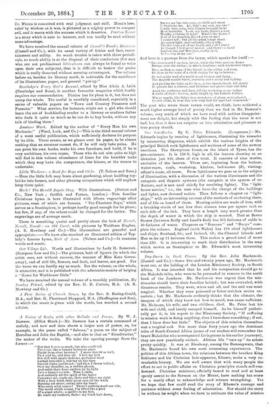Our Sea-Marks. By E. Price Edwards. (Longmans.)—Mr. Edwards begins by
treating of lighthouses, illustrating his remarks by interesting diagrams, which exhibit the various heights of the principal British rock lighthouses and sections of some of the newest erections. The Skerryvore house, on the island of Tyree, has the- pre-eminence. It is 158 ft. bigh in all, the lantern showing at an elevation just 8 ft. short of this total. It consists of nine stories, exclusive of the lantern. These are, beginning from the bottom, water-room, coals, workshop, kitchen, bed-rooms (2), visiting. officer's room, oil-room. From lighthouses we pass on to the subject of illumination, with a discussion of the various illuminants and the catoptric and dioptric systems (the catoptric is the system of re- flectors, and is now used chiefly for revolving lights). The "light- house service," i.e., the men who have the charge of the buildings and lights, now demand notice. Then follows a chapter on "light- ships," with an interesting account of the methods of anchoring them, and of life on board of them. Mooring-cables are made of iron, with a breaking strain of not less than sixteen tons per square inch on each aide of the link. They have a length very much greater than the depth of water in which the ship is moored. That at Seven Stones (between Scilly and Land's End) has 315 fathoms of cable in. 40 fathoms of water. Chapters on "Beacons" and "Buoys" com- plete the volume. England (with Wales) has 118 chief lighthouses and ships; Scotland, 64; and Ireland, 63; the Channel Islands and Man make up 11 between them. This makes a grand total of more than 250. It is interesting to mark their distribution in the map which serves as frontispiece to Mr. Edwardea most interesting volume.






































 Previous page
Previous page